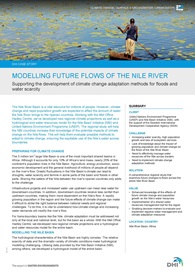Floods and water scarcity – supporting climate change adaptation in the Nile River Basin
With the Met Office Hadley Centre, we developed new regional climate projections and a hydrological and water resources model. This model was used to project future flows in the entire Nile River Basin.
 With the Met Office Hadley Centre, we developed new regional climate projections and a hydrological and water resources model. This model was used to project future flows in the entire Nile River Basin.
With the Met Office Hadley Centre, we developed new regional climate projections and a hydrological and water resources model. This model was used to project future flows in the entire Nile River Basin.
Agriculture, energy production, socio-economic development and the general livelihood of millions of people all depend on the flow of the Nile River. However, climate change and rapid population growth are expected to affect the amount of water the river brings to the riparian countries.
For trans-boundary basins like the Nile, climate adaptation measures must be addressed – not only at the local and national level, but for the basin as a whole. As such, we utilised data provided by the Nile Basin Initiative (NBI) and member countries to develop a hydrological model of the entire 3 million km2 large basin. With the comprehensive study and hydrological model, the NBI:
- has gained a better idea of the impacts of changes in climate and water demand on the future flows in the region
- has a better knowledge basis to formulate a regional water policy for climate change adaptation
- will be able to develop and implement coordinated regional, national and local climate adaptation plans
In addition, we provided training (with the Met Office) to representatives from the NBI countries on how to use the hydrological model to estimate the effect of climate change on water resources. The model will also serve as a shared water resources management tool for the NBI countries.
The applicability of the approach used for the Nile Basin can be used for large and small basins worldwide that are vulnerable to the effects of climate change.
Read more